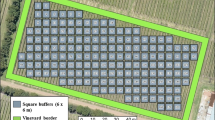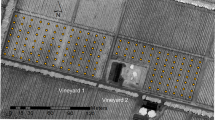Abstract
Spatial variability of Chilean vineyards, in terms of yield and quality, is high, which fully justifies site-specific management, particularly differential harvest. In this study, the most common zoning tools (NDVI and ECa measurements) were evaluated and compared. Comparisons also included a calibrated GVI. Two contrasting large field experiments (pruning, irrigation, and N fertilization treatments) were established in vineyards to (1) evaluate two vegetation indices: (i) a non-calibrated airplane-based NDVI and (ii) calibrated satellite-based GVI and to (2) evaluate the ECa measurements. The GVI was also assessed at the commercial level, in different vineyards and valleys. The GVI was more sensitive in discriminating grape yields and quality while the NDVI failed to adequately sense vigor patterns and fruit quality in the more homogeneous site. Thus, a calibrated GVI can be recommended as a better tool than NDVI for defining management zones as well as making spatial and temporal comparisons among fields and seasons. In general, ECa explained few differences in the alluvial soil properties and did not predict differences in plant vigor as measured by either vegetation indices, therefore ECa by itself was not a good estimator of the most commonly measured soil properties for establishing management zones in these fields with low variability in terms of EC and other soil characteristics.







Similar content being viewed by others
Abbreviations
- NDVI:
-
Normalized difference vegetation index
- GVI:
-
Green vegetation index
- ECa:
-
Apparent soil electrical conductivity
References
Bassoi, L., Hopman, J., Castro, D., Miranda, C., & Moura, J. (2003). Grapevine root distribution in drip and microsprinkler irrigation. Scientia Agricola, 60, 377–387.
Bordeu, E., & Scarpa, J. (1998). Análisis Químico del Vino. Santiago: Ediciones Pontificia Universidad Católica de Chile.
Bramley, R. G. V. (2001). Variation in the yield and quality of winegrapes and the effect of soil property variation in two contrasting Australian vineyards. In ECPA—3rd European conference on precision agriculture (pp. 767–772), Montpellier, France.
Bramley, R. G. V., & Hamilton, R. P. (2004). Understanding variability in winegrape productions systems. 1. Within vineyard variation in yield over several vintages. Australian Journal of Grape and Wine Research, 10, 32–45.
Bramley, R. G. V. & Lamb, D. W. (2003). Making sense of vineyard variability in Australia. In International symposium on precision viticulture (pp. 35–54). Santiago: Centro de Agricultura de Precisión, Pontificia Universidad Católica de Chile.
Bramley, R. G. V., Ouzman, J., & Thornton, C. (2011). Selective harvesting is a feasible and profitable strategy even when grape and wine is geared towards large fermentation volumes. Australian Journal of Grape and Wine Research, 17, 298–305.
Cortell, J., Halbleib, M., Gallagher, A., Righetti, T., & Kennedy, J. (2007). Influence of vine vigor on grape (Vitis vinifera L. cv. Pinot Noir) anthocyanins. I. Anthocyanin concentration and composition in fruit. Journal of Agricultural and Food Chemistry, 55, 6575–6584.
Corwin, D. J., & Lesch, S. M. (2005). Apparent soil electrical conductivity in agriculture. Computers and Electronics in Agriculture, 46, 11–43.
Crist, E. P., & Cicone, R. C. (1984). Application of the tasseled cap concept to simulated thematic mapper data. Photogrammetric Engineering and Remote Sensing, 50, 343–352.
Dobrowsky, S. Z., Udtin, S. L., & Wolpert, J. A. (2003). Grapevine dormant pruning weight prediction using remotely sensed data. Australian Journal of Grape and Wine Research, 9, 177–182.
Dry, P. R. (2000). Canopy management for fruitfulness. Australian Journal of Grape and Wine Research, 6, 109–115.
Fortes, R., Millán, S., Prieto, M. H., & Campillo, C. (2015). A methodology based on apparent electrical conductivity and guided soil samples to improve irrigation zoning. Precision Agriculture, 16, 441–454.
Gil-Pérez, B., Zarco-tejada, P., Correa-Guimaraes, A., Relea-Gangas, E., Navas-Gracia, L., Hernández-Navarro, E., et al. (2010). Remote sensing detection of nutrient uptake in vineyards using narrow-band hyperspectral imaginery. Vitis, 49, 167–172.
Hall, A., Lamb, D. W., Holzapfel, B., & Louis, J. (2002). Optical remote sensing in viticulture—a review. Australian Journal of Grape and Wine Research, 8, 36–47.
Hall, A., & Wilson, M. A. (2013). Object-based analysis of grapevine canopy relationships with winegrape composition and yield in two contrasting vineyards using multitemporal high spatial resolution optical remote sensing. International Journal of Remote Sensing, 34, 1772–1797.
Jackson, R. D. (1983). Spectral indexes in n-space. Remote Sensing of Environment, 13, 409–421.
Kauth, R. J. & Thomas, G.S. (1976). The tasseled cap. A graphic description of the spectral-temporal development of agricultural crops as seen by Landsat. In Proceedings of the symposium on machine processing of remotely sensed data (pp. 41–51). West Lafayette, IN: Purdue University.
Kriegler, F. J., Malila, W. A., Nalepka, R. F. & Richardson, W. (1969). Preprocessing transformations and their effects on multispectral recognition. In Proceedings of the sixth international symposium on remote sensing of environment (pp. 97–131). Ann Arbor, MI: University of Michigan.
Ladha, J. K., Pathak, H., Krupnik, T., Six, J., & Van Kessel, C. (2005). Efficiency of fertilizer nitrogen in cereal production: retrospects and prospects. Advances in Agronomy, 87, 85–156.
Lamb, D. W., Bramley, R. G. V., & Hall, A. (2004a). Precision viticulture—an Australian perspective. Acta Horticulturae, 640, 15–25.
Lamb, D. W., Weedon, M. M., & Bramley, R. G. V. (2004b). Using remote sensing to predict grape phenolics and colour at harvest in a Cabernet Sauvignon vineyard: timing observations against vine phenology and optimising image resolution. Australian Journal of Grape and Wine Research, 10, 46–54.
Lund, E. D., Christy, C., & Drummond, P. (1999). Practical applications of soil electrical conductivity mapping. In J. Stafford (Ed.), Precision Agriculture ’99 (pp. 771–779). Sheffield: Sheffield Academic Press Ltd.
Mabrouk, H., & Sinoquet, H. (1998). Indexes of light microclimate and canopy structure of grapevine as determined by 3D digitising and image analysis, and their relationship to grape quiality. Australian Journal of Grape and Wine Research, 4, 2–13.
Martínez-Casasnovas, J., Agelet-Fernández, J., Arno, J., & Ramos, M. (2012). Analysis of vineyard differential management zones in relation to vine development, grape maturity and quality. Spanish Journal of Agricultural Research, 10, 326–337.
Mellio, F., Zarco-Tejada, C., Núñez, L., Sepulcré-Cantó, G., González, M., & Martin, P. (2010). Grape quality assessment in vineyards affected by iron deficiency chlorosis using narrow band physiological remote sensing indexs. Remote Sensing of the Environment, 114, 1968–1986.
Moral, F., Terrón, J., & Marques da Silva, J. (2010). Delineation of management zones using mobile measurements of soil apparent electrical conductivity and multivariate geostatistical techniques. Soil and Tillage Research, 106, 335–343.
Morari, F., Castrignano, A., & Pagliarin, C. (2009). Application of multivariate geostatistics in delineating managements zones within a gravelly vineyard using geo-electrical sensors. Computers and Electronics in Agriculture, 68, 97–107.
ODEPA. (2015). Estadísticas, Productivas, Estadísticas de vides. Oficina de Estudios y Políticas Agrarias, Estadísticas. Ministerio de Agricultura, Gobierno de Chile. Accessed 10 July, 2015, from http://www.odepa.cl/vides-superficie-y-produccion-3/.
Ortega, R. & Esser, A. (2003). Precision viticulture in Chile: Experiences and potential impacts. In International symposium on precision viticulture (pp. 9–33). Santiago: Centro de Agricultura de Precisión, Pontificia Universidad Católica de Chile.
Ortega, R., Esser, A., & Santibáñez, O. (2003). Spatial variability of wine grape yield and quality in Chilean vineyards: Economic and environmental impacts. In J. Stafford & A. Werner (Eds.), Precision agriculture (pp. 499–506). Wageningen: Wageningen Academic Publishers.
Ough, C. S., & Nagaoka, R. (1984). Effects of cluster thinning and vineyard yields on grape and wine composition and wine quality on Cabernet Sauvignon. American Journal of Enology and Viticulture, 35, 30–34.
Rodríguez-Pérez, J. R., Plant, R. E., Lambert, J. J., & Smart, D. R. (2011). Using apparent soil electrical conductivity (ECa) to characterize vineyard soils of high clay content. Precision Agriculture, 12, 775–794.
Rouse, J. W., Haas, R. H., Schell, J. A. & Deering, D. W. (1973). Monitoring vegetation systems in the great plains with ERTS. In Third ERTS Symposium, NASA SP-351 (Vol. 1, pp. 309–317).
Sadzawka, A., Carrasco, M., Grez, R. & Mora, M. L. (2004). Métodos de Análisis Recomendados para los Suelos Chilenos. Santiago, Chile: Comisión de Normalización y Acreditación, Sociedad Chilena de la Ciencia del Suelo.
SAS Institute Inc. (2001). SAS user’s guide. Version 8.02. Cary, NC: SAS Institute.
Schmulik, P. F. (2005). Soil properties influencing apparent electrical conductivity: a review. Computers and Electronics in Agriculture, 46, 45–70.
Suddth, K. A., Kitchen, N. R., Wiebold, W. J., Batchelor, W. D., Bollero, G. A., Bullock, D. G., et al. (2005). Relating apparent electrical conductivity to soil properties across the north-central USA. Computers and Electronics in Agriculture, 46, 263–283.
Taylor, J. A., Acevedo-Opazo, C., Ojeda, H., & Tisseyre, B. (2010). Identification and significance of sources of spatial variability in grapevine water status. Australian Journal of Grape and Wine Research, 16, 218–226.
Acknowledgments
Part of the reported data comes from the FONDEF project D02I1045 headed by the first author from 2002 to 2004. Authors would like to thank Mr. Jorge Nuñez and Mr. Andrés Esser for their collaboration in the GVI evaluation at the commercial level.
Author information
Authors and Affiliations
Corresponding author
Rights and permissions
About this article
Cite this article
Ortega-Blu, R., Molina-Roco, M. Evaluation of vegetation indices and apparent soil electrical conductivity for site-specific vineyard management in Chile. Precision Agric 17, 434–450 (2016). https://doi.org/10.1007/s11119-016-9429-x
Published:
Issue Date:
DOI: https://doi.org/10.1007/s11119-016-9429-x




